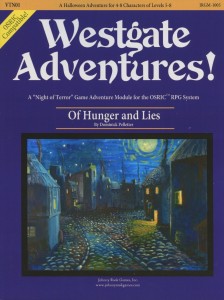A creature stalks the streets of Westgate Town, feasting on the humble lower class citizens. The locals believe the monster to be a werewolf and hire both a famed werewolf hunter and a party of adventurers to seek out and defeat the beast before it strikes again!
This is an investigative adventure in a portion of a large city with a very heavily timeline-based element. The city-based nature will make it hard for a DM to run, like all city games, however the core villain is quite interesting.
In the Baldur’s Gate 2 video game I have memories of walking in to a random house and exclaiming to myself “Holy $%^&! What the $&%^ is this?!” The guys house was full of corpses and skins. Cities are a great place to have an adventure. There are lots and lots of people to interact with with all of the role-playing opportunities that represents. And some of people are going to have secrets. As a DM you have to manage large groups of NPC’s and environments and make them all interesting to the party AND remember where they are and what they do. Then you have to stick an adventure on top of it. A well-run city game is perhaps the hardest type to run but one of the best you’ll ever play in.
This adventure module takes place in a city, or rather, in a section of a city. A great deal of the module describes the various buildings, businesses, NPC’s and homes in that section. A small timeline is then presented. The party is free to do as they wish. In my experience this generally means “make a mess of things.”
Our core villain in this adventure is reaching his breaking point. The woman he has loved from afar is getting married, breaking his heart. The local guild is pressuring him to join … through the use of thugs, thieves and heavies. Then his business evaporates. So far not too bad. Then the statue of a goddess he’s working on starts talking to him, and promising him a solution. He accidentally gets started on a path that leads him to kill and eat people, which will eventually turn him in to a demon. He gets a long backstory, over 1.5 pages, that goes in to his history and motivations. There’s then another two pages that describe his various powers & abilities as the adventure progresses. Essentially, he gets more powerful as he eats people and he’s doing that every night, so the provided charts help greatly in providing his stats, abilities, appearance, and the like. I generally don’t like a long backstory, and I still don’t. The Barrow Mound of Gravemoor had a villain with very personal, and very human, motivations as well, but did it in far fewer words. The story does paint a very good and very personal picture of a defeated man, and that sort of detail is very unusual in a module. Villains tend to be much more cookie-cutter and I much prefer to have them more fully fleshed out. Of course, this has to somehow be communicated to the players to be effective. We don’t want to wander in to the final room only to discover a hidden mastermind we never knew existed. Yes, Lareth, we’re looking at you. The various murders do a decent job of building up the villain, however his motivations remain hidden, probably throughout the adventure, and will almost certainly never be known to the players. Which means a lot of what was written is wasted.
The city section is large with almost 160 buildings, shops, and homes described, along with the various NPC’s that inhabit them. That’s probably 200 people, at least. Each has at least a couple of sentences to describe it, with most having considerable more. Some are weird, a couple have a decent personality a DM can work with, however most are just plain craftsmen and merchants. I like my NPC’s to have strong personalities and other elements associated with them. I find this helps run a much more successful city based adventure. There is A LOT going on, and the DM probably will need to take some time and mark up his map to help run the adventure more smoothly.
The timeline takes place over 3.5 pages. Essentially it details what should happen each day and each evening until the villain goes completely nuts, and then details what he tries to do. This is the section I have the most problem with since it contains lots of phrasings stating that the villain should get away. Combined with a villain that has several shapeshifting and movement powers, it’s going to be very hard for a party to tie him down prior to the completion of his transformation, at which point he just plane shifts away. What we’re left with is an adventure in which the party goes through the motions of doing something, only to have their efforts prove meaningless. This type of adventure is very hard to write because of that very issue. There is generally a Right Way to solve the mystery, and the party can either become frustrated if they don’t catch on, or stumble upon the solution quickly. It’s been my experience that players generally fall in to the former category. Pacing is crucial here, as the module correctly points out, but there’s a lot of room for a busted adventure, and not in a good way.


Thanks for the extensive reviews. We appreciate it! We’d love to share a dialogue about our games, especially the perceived negatives because we feel there may be miscommunication about some aspects of the products. We do try to provide review copies of new products, and you’re welcome to contact us if you’re interested.